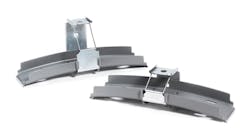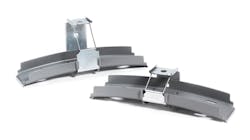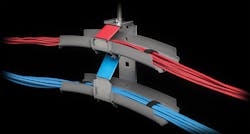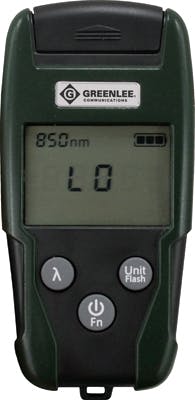CABLE MANAGEMENT
J-hook extender enables 12-inch cable support
A cable-management tool that its manufacturer says “bridges the gap between the J-hook and a cable tray” provides a 12-inch-long by 2.75-inch-wide support platform. MonoSystems’ J-hook Cable Support Extender “has been proven to reduce cable stress points, strain, sage, and heat buildup,” the company said. “All are key factors relating to today’s J-hook installations.”
The extender is a plenum-rated J-hook platform that is “designed to easily snap into the MonoSystems infinitely linkable J-hook system called The Hook,” the company continued. Introduced several years ago, The Hook system allows patented J-hooks to link together without the need for additional hardware or labor. The Hook System creates “a secure, tiered cable support system for segregation of cabling media into separate pathways to prevent crossover.”
Mono Systems points to The Hook System’s wide, flat base, explaining these physical characteristics reduce cable stress points and pinching. When the extender is used with The Hook, the combined unit “provides an extended platform that offers greater support while avoiding heat buildup. The J-hook Cable Support Extender was designed in a gray, UL94 plenum-rated material. The gray color closely matches the steel J-hooks, so as not to create any confusion, or draw attention to any colors potentially used to identify a specific run.”
Mark Ross, director of marketing with MonoSystems, says the extender “provides the best of both worlds—lower material costs, less labor, installation flexibility and better support for high-performance cables.”
In a document titled “Advancements in J-hook design,” MonoSystems describes advantages of The Hook System’s flat base. “As cable capacity grows, it has been shown that the face of the curved J-hook forces unnecessary pressure on the cables located toward the bottom center of the hook, which could negatively impact overall network performance. A flat-profile J-hook provides a number of advantages. Cables naturally nestle in between adjacent cables, so pressure is evenly disbursed throughout the J-hook. The wider, flatter base provides even weight distribution and also helps minimize cable sag.”
The same document states of the J-hook Cable Support Extender, “eliminates point load by increasing the cable support surface from 2 inches to 12 inches. Additionally, the cable support extender’s perforated flat bottom allows cables to spread out rather than bunch, reducing heat buildup related to Power over Ethernet.”
Several of the extender’s users have lauded the new product. “The new J-hook cable support extender is an awesome addition for our high-performance cabling,” said John Kacperski, senior technology systems designer with PS2 Engineering Inc. “And the combination of the steel J-hook and plenum-rated extender makes the entire assembly safer for fire-related issues in the ceiling.”
Chris Dobosz, estimator and project manager with Vision Communications in Wichita, KS, added, “We have already installed thousands of [The Hook System components] and love the way we can easily add tiers without the need for additional hardware. They just snap right on. We are also certified for Sumitomo blown fiber, and the new J-hook cable extender has taken the flat-based design of the J-hooks to a new level. We have started using these extenders for tube cable installations with fantastic results.”u
TESTING
Greenlee’s Micro OPM blends optical power meter, VFL functions for troubleshooting fiber networks
Greenlee Textron Inc. announced the addition of the Micro OPM tester to its line of fiber-optic test and measurement instruments. The Micro OPM includes an optical power meter (OPM) and visual fault locator (VFL) in one unit, providing technicians with an efficient and simple-to-use tool for troubleshooting fiber-to-the-x and point-to-point networks. The combination tool is compatible with both singlemode and multimode fiber-optic networks.
The new unit’s versatile OPM measures the optical power and insertion loss of a fiber using an InGaAs detector calibrated at wavelengths from 850 to 1625 nm, and features tone detection at 270 Hz, 1 kHz and 2 kHz for measuring all common wavelengths and identifying injected tones from compatible sources. The OPM is available in standard telco (+6 to -70dBm) and MSO (+26 to -50dBm) power ranges.
The tester’s VFL function uses a 650-nm 1-mW laser that can be used to safely detect macrobends, contaminated or faulty connectors and broken or damaged fibers. The white LED can be used to aid the technician while working in dimly lit locations.
“The Micro OPM is the perfect tool for every fiber technician. It does exactly what is needed, is intuitive and is accessible to all,” concludes Oleg Fishel, director of product management for Greenlee Communications.
About the Author
Matt Vincent
Senior Editor
Matt Vincent is a B2B technology journalist, editor and content producer with over 15 years of experience, specializing in the full range of media content production and management, as well as SEO and social media engagement best practices, for both Cabling Installation & Maintenance magazine and its website CablingInstall.com. He currently provides trade show, company, executive and field technology trend coverage for the ICT structured cabling, telecommunications networking, data center, IP physical security, and professional AV vertical market segments. Email: [email protected]




